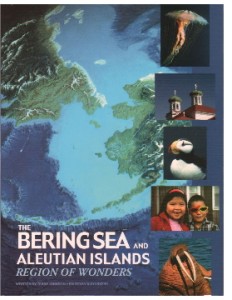 Alaska’s Aleutian Islands span some 1,200 miles across the North Pacific Ocean dividing the Bering Sea from the Gulf of Alaska to the south. An area rich in seafood, coastal communities in both Russia and Alaska depend greatly on the marine resources of this region. Terry Johnson, a Marine Advisory Program Agent in Homer, Alaska has written a remarkable guide to the Aleutians and Bering Sea. Consider reading The Bering Sea and Aleutian Islands: A Region of Wonders, an adventure supported through photography, art work, illustration, mapping, and radio archives.
Alaska’s Aleutian Islands span some 1,200 miles across the North Pacific Ocean dividing the Bering Sea from the Gulf of Alaska to the south. An area rich in seafood, coastal communities in both Russia and Alaska depend greatly on the marine resources of this region. Terry Johnson, a Marine Advisory Program Agent in Homer, Alaska has written a remarkable guide to the Aleutians and Bering Sea. Consider reading The Bering Sea and Aleutian Islands: A Region of Wonders, an adventure supported through photography, art work, illustration, mapping, and radio archives.
A Wealth of Expert Knowledge – Just as this is a diverse region within Alaska, describing it effectively depends on multiple media treatments. In publishing this book, the Alaska Sea Grant College Program uses the prose of Terry Johnson, editing by Kurt Byers, and radio stories produced by Douglas Schneider to better describe the area. Photographs in the book come from Alissa Crandall, Fred Hirchmann, and the UAF Rasmuson Library. Fish and invertebrate illustrations were provided by Sandra Noel. Maps produced by the University of Alaska Fairbanks, Alaska Department of Education and Alaska Geographic Alliance were adapted for use in the book by Tatiana Piatanova. As with all Alaska Sea Grant publications, information presented was thoroughly vetted by subject matter experts through the oversight of the National Oceanic and Atmospheric Administration (NOAA).
Project Sponsorship – Work presented in this book was sponsored by an organization created by Congress in 1999, the North Pacific Marine Research Program (NPMR). Information is presented topically, leaving it up to the reader how best use the material presented. Subjects can be explored by topic or the book read from cover to cover. Material presented is supported by complete references and a subject index.
Topical Table of Contents – Major areas of discussion are separated topically, with information richly presented through the text, illustrations, and sidebar discussions.
- Global Context – A picture of the region in global perspective. Descriptions of coastlines, rivers, continental shelf, sea ice, natural resources, and marine ecosystems are included
- Physical Environment – The Aleutians is a major segment in the Pacific Ring of Fire, an area affected by continental drift and resultant volcanism. Plate tectonics, volcanism, and glaciation have all formed the shape of the land. Ocean currents, swells, topography, and great tides impact the region’s physical environment
- Life in the Sea – Marine life is rich and diverse in the Bering Sea. Half of the seafood produced in the United States comes from the waters of Alaska, with the Bering Sea chief among them. Photographs, illustrations, and written descriptions are presented for all the major fish, marine mammal, plant, and invertebrate species that reside in the area
- Life above the Sea – Life on the Aleutian Islands is abundant and the islands provide critical habitat for many seasonal animal visitors to the Bering Sea. The variety of birds alone is a driver in the region’s booming eco-tourism movement
- Minerals and Energy – Extraction of the natural resources of oil, natural gas, and gold have shaped the history of the region. Huge potential reserves exist today. The Aleutians are strategically located on the Great Circle shipping route from the West Coast of the United States to Far East ports in China, Korea, and Japan
- Culture and Commerce – Native people have occupied and flourished here for 30,000 years. Yupiks, Inupiats, and Aleuts people all developed rich cultures along the shores of the Aleutian Islands and Bering Sea. Russia colonized the islands and brought its culture to the Native people. Europeans of all stripes held brief visits and eventually Alaska was purchased by the United States in 1867. Johnson’s book details the effect of commercial fisheries, subsistence lifestyles, and harvest of marine mammals has had on residents
- Managing the Resources – Natural resources depend on thoughtful management to insure their long term productivity. The Bering Sea’s resources are managed by an alphabetic host of agencies, each with specific interests and legal authorities. Resource co-management with Alaska Natives of commercial fishing and subsistence gathering is becoming common
- Challenges – The Bering Sea is seen as a mosaic of failures and successes. Demands on the region’s natural resources from a growing world population and environmental concerns complicate decision making in the Arctic.
Terry Johnson and the team at the Alaska Sea Grant Program have produced a wonderful resource describing the Bering Sea and Aleutian Islands. Information presented will make all us students of the region, better advocates for continued research and wish to spend a little more time there. The Bering Sea and Aleutian Islands: Region of Wonders (ISBN 1566120810) is published by the Alaska Sea Grant College Program and retails for $29.95. A compact disk of nine radio stories produced for the North Pacific Marine Research Program is included.
Copyright © 2013 by Alan Sorum